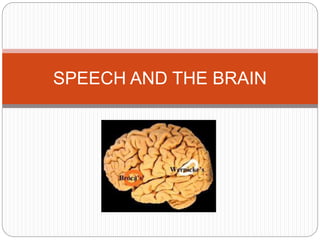
Speech and the Brain
- 1. SPEECH AND THE BRAIN
- 2. Lateralization The brain is divided into two halves, a left hemisphere and a right hemisphere. This is called lateralization
- 3. Lateralization In human beings, the left hemisphere that usually contains the specialized language areas. This holds true for 97% of right-handed people, about 19% of left-handed people have their language areas in the right hemisphere and as many as 68% of them have some language abilities in both the left and the right hemispheres.
- 5. Lateralization Lateralization was first discovered in the 1800's by physicians such as Paul Broca and Carl Wernicke These physicians found damage to particular areas of the brain now named after them, and these areas were consistently on the left hemisphere.
- 6. Lateralization Most recently, researchers have taken advantage of the huge advances made in brain imaging. In particular, the PET scan Since active areas of the brain use more energy, and therefore more glucose, they release more radiation, which the computer translates into "warmer" colors such as yellow and red. Areas that are less active are shown with "cooler" colors such as green and blue. Certain areas of the left hemisphere were more active while people were engaged in linguistic activities.
- 8. Introduction to Broca and Wernicke’s Areas broca and wernicke areas
- 9. Broca’s Area
- 10. Broca’s Area The first language area within the left hemisphere to be discovered is called Broca's Area, after Paul Broca.
- 11. Broca’s Area Broca was a French neurologist who had a patient with severe language problems. He could understand the speech of others with little difficulty, but the only word he could produce was "tan." Because of this, Broca gave the patient the pseudonym "Tan.” After the patient died, Broca performed an autopsy, and discovered that an area of the frontal lobe, just ahead of the motor cortex controlling the mouth, had been seriously damaged.
- 12. Broca’s Area Physicians called the inability to speak aphasia, and the inability to produce speech was therefore called Broca's aphasia, or expressive aphasia. sarah scott - broca's aphasia sarah scott - 3 years later
- 13. Broca’s Area Someone with this kind of aphasia has little problem understanding speech. But when trying to speak themselves they are capable only of slow, laborious, often slurred sequences of words. They don't produce complete sentences, seldom use regular grammatical endings such as -ed for the past tense, and tend to leave out small grammatical words.
- 14. Broca’s Area It turns out that Broca's area is not just a matter of getting language out in a motor sense, though. It seems to be more generally involved in the ability to deal with grammar itself, at least the more complex aspects of grammar. For example, when they hear sentences that are put into a passive form, they often misunderstand: If you say "the boy was slapped by the girl," they may understand you as communicating that the boy slapped the girl instead.
- 15. Wernicke’s Area
- 16. Wernicke’s Area The second language area to be discovered is called Wernicke's Area, after Carl Wernicke, a German neurologist.
- 17. Wernicke’s Area Wernicke had a patient who could speak quite well, but was unable to understand the speech of others. After the patient's death, Wernicke performed an autopsy and found damage to an area at the upper portion of the temporal lobe, just behind the auditory cortex. He correctly hypothesized that this area was responsible for speech comprehension.
- 18. Wernicke’s Area This kind of aphasia is known as Wernicke's Aphasia, or receptive aphasia. When you ask a person with this problem a question, they will respond with a sentence that is more or less grammatical, but which contains words that have little to do with the question or, for that matter, with each other. Strange, meaningless, but grammatical sentences come forth, a phenomenon called
- 19. Wernicke’s Area Like Broca's area is not just about speech production, Wernicke's is not just about speech comprehension. People with Wernicke's Aphasia also have difficulty naming things, often responding with words that sound similar, or the names of related things, as if they are having a very hard time with their mental "dictionaries.“ wernicke's aphasia - amelia carter